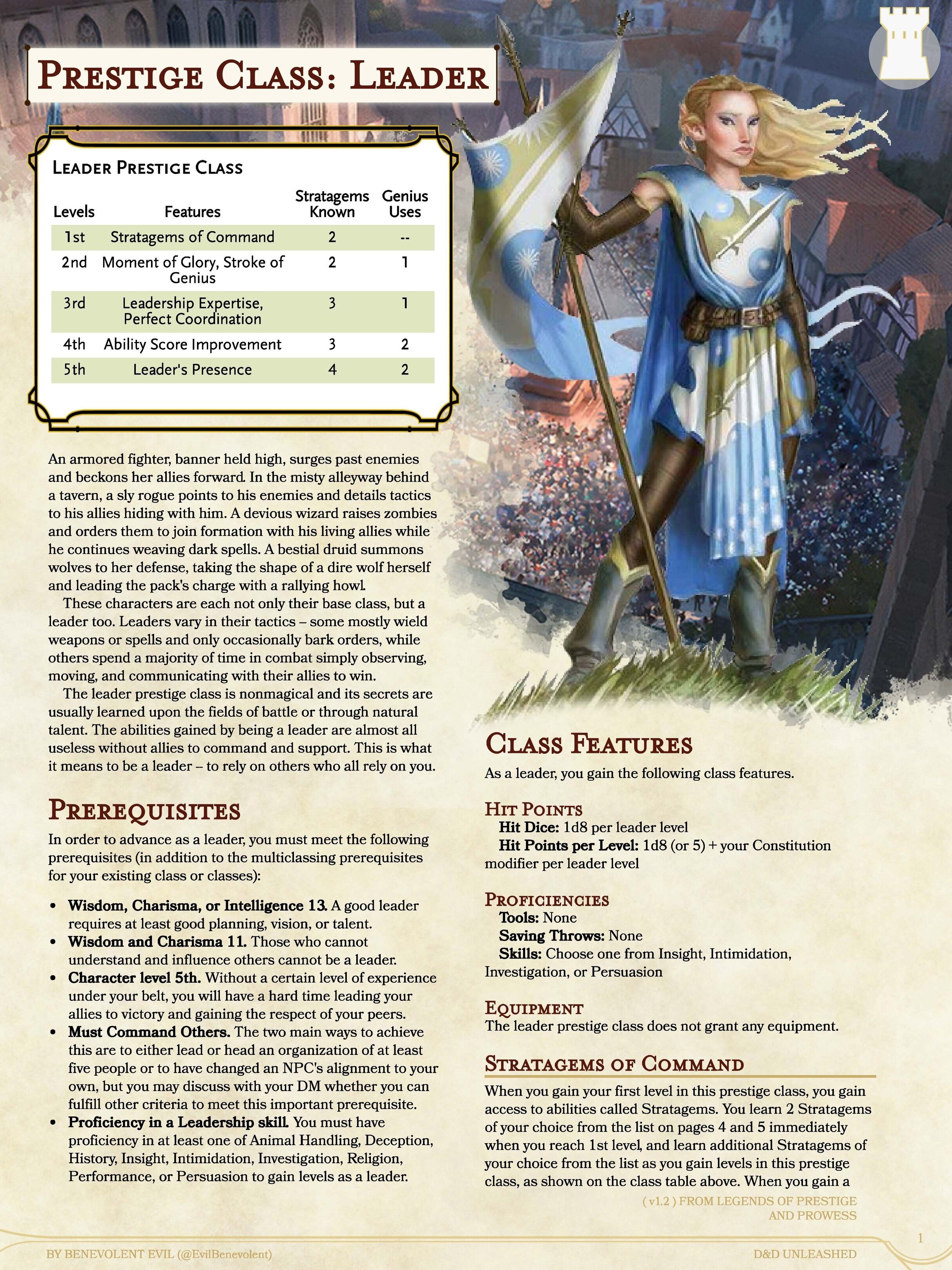The Leader (Prestige Class)
It’s finally ready for primetime — the first prestige class that we can preview: The Leader!
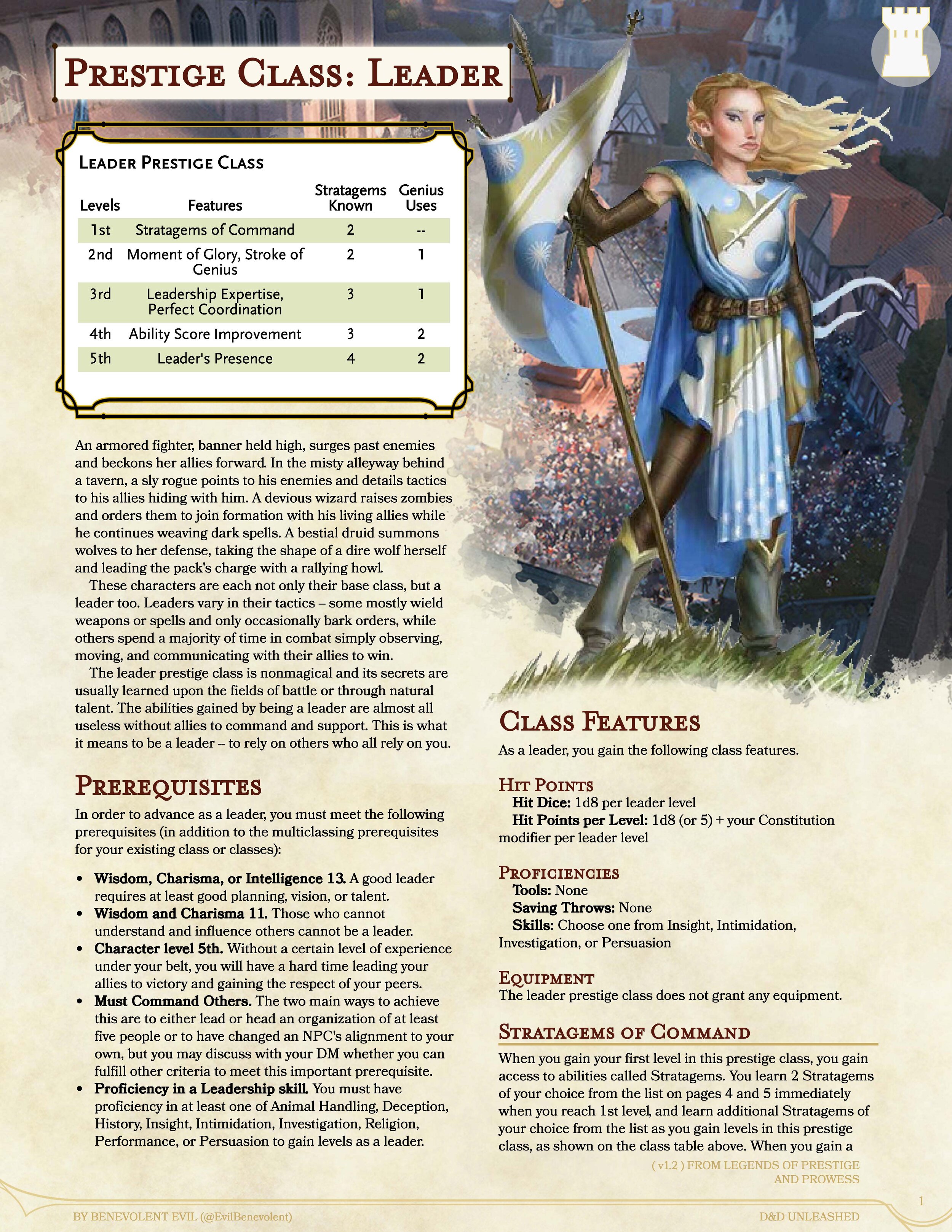
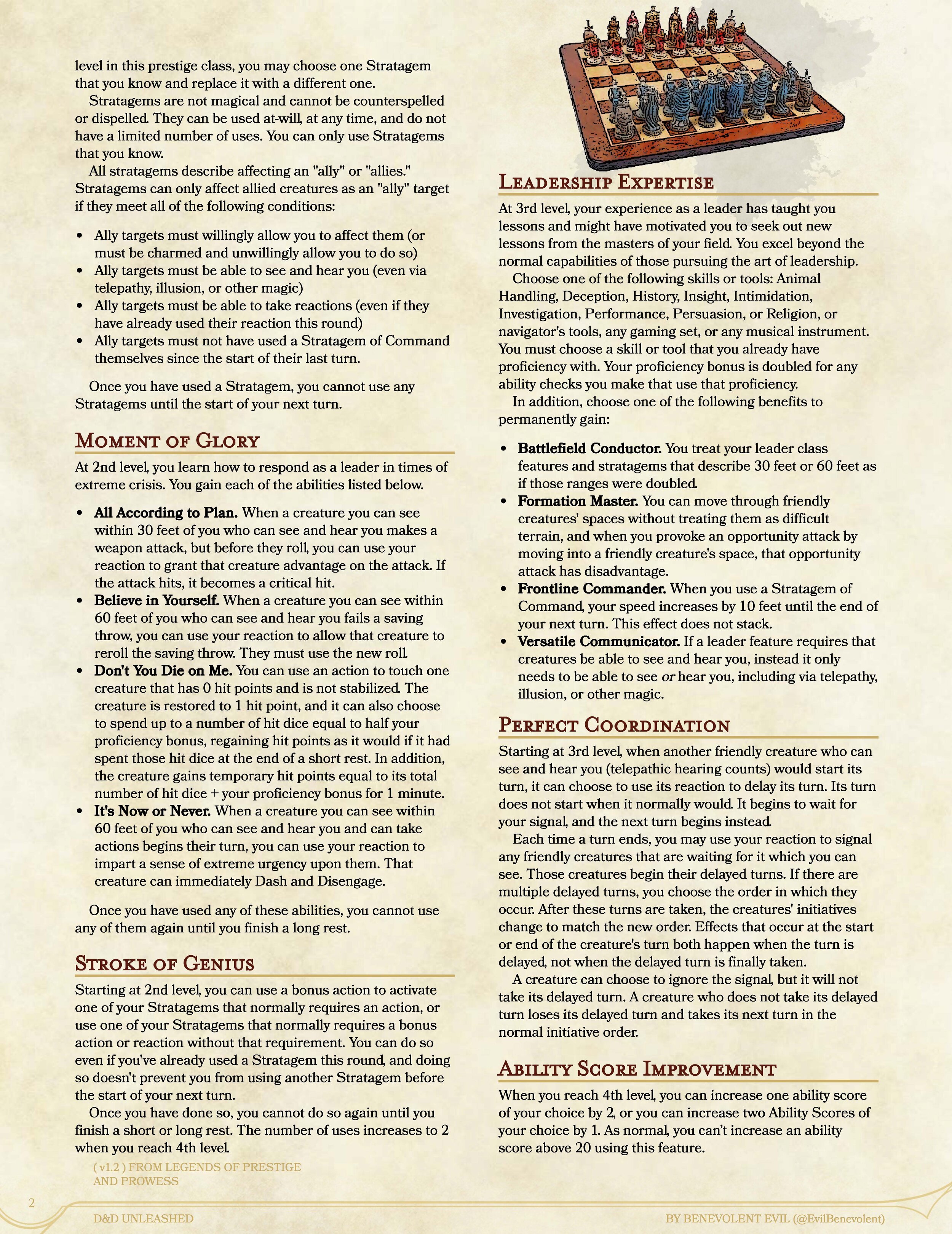
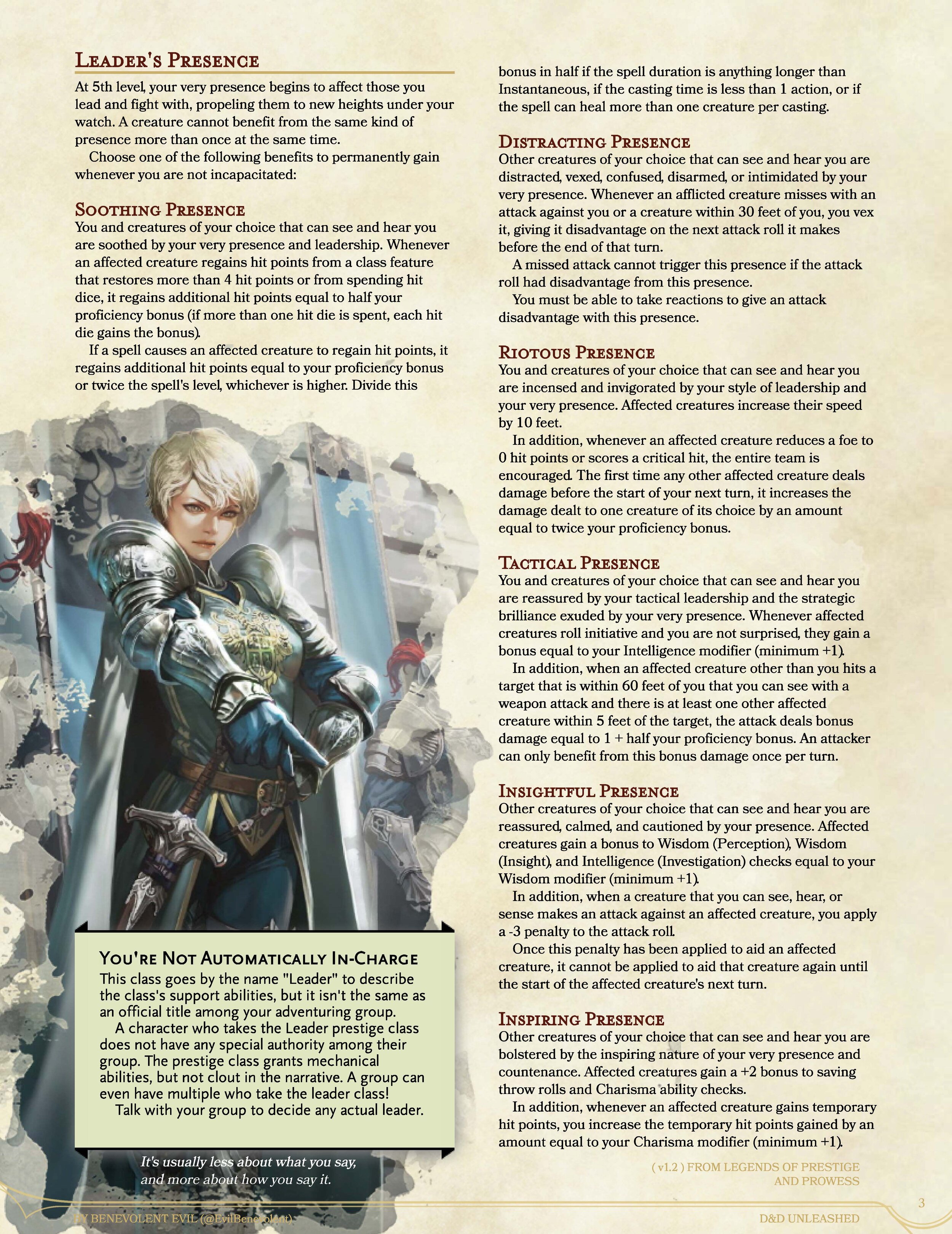
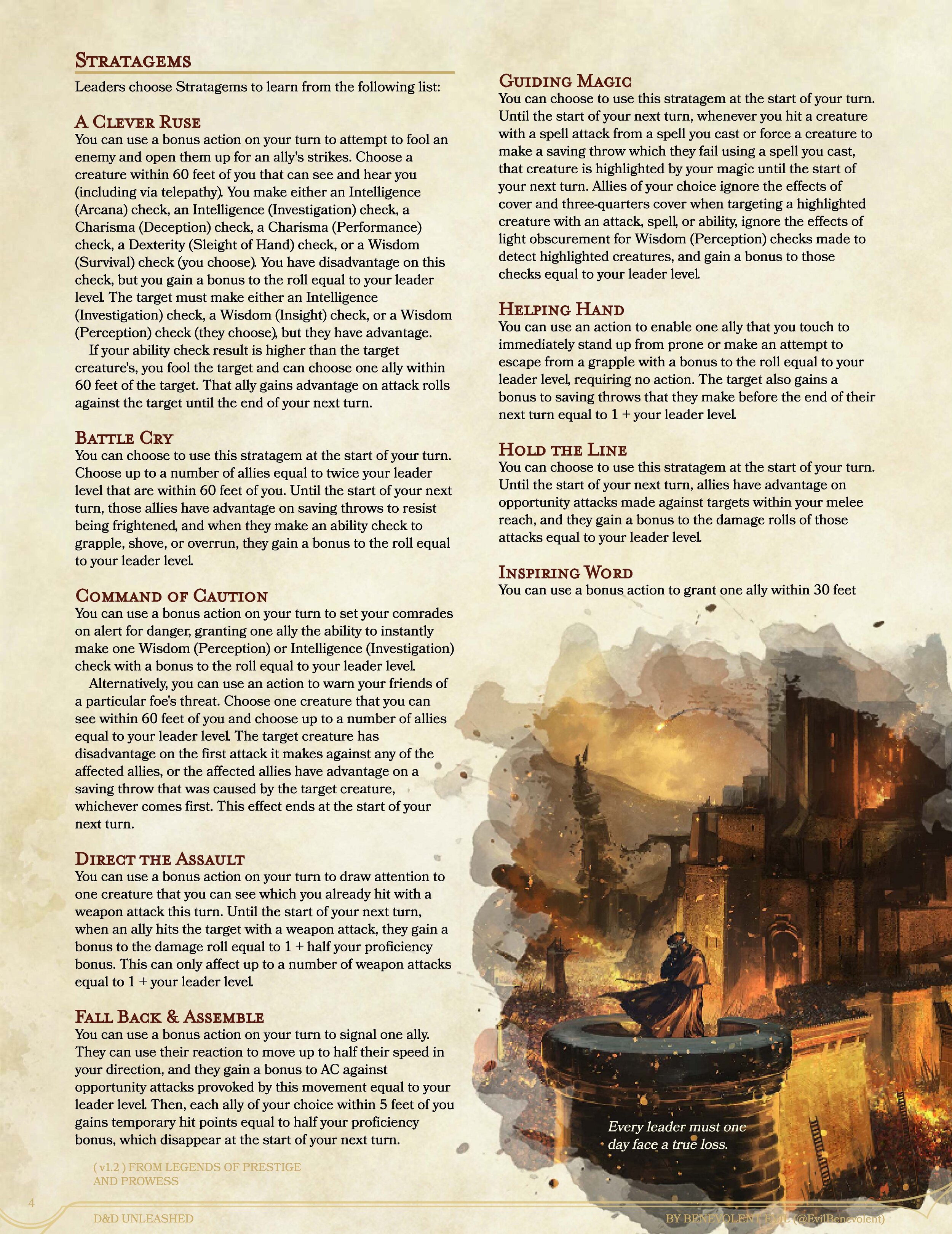
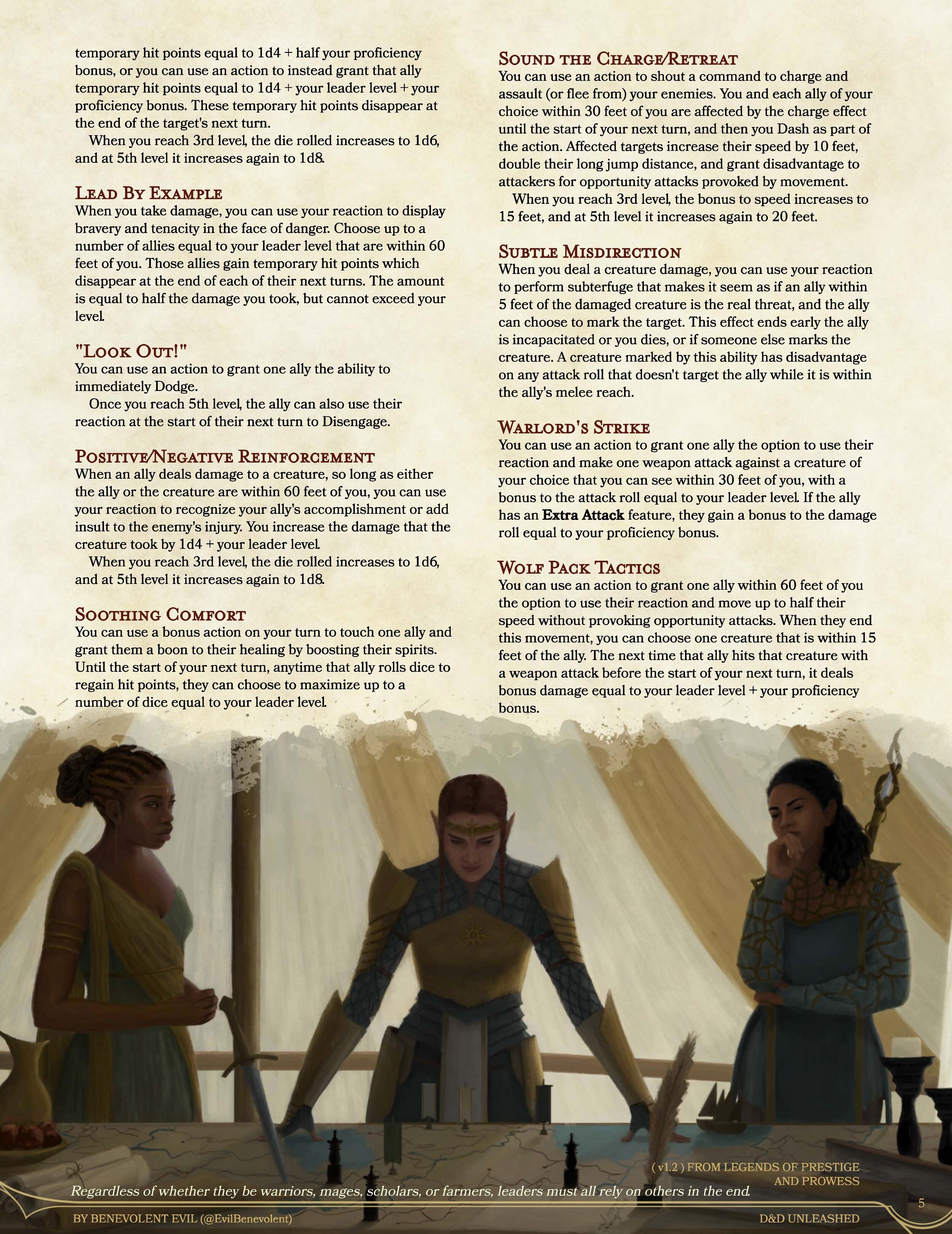
The Leader is designed to work with a wide range of character concepts, spanning from the brave and inspiring sergeant wielding a sword and banner and heading the charge to the intellectual spellcaster laying careful traps for enemies and using allies as chess pieces. It can be used to make use of bonus actions and reactions, with little change to the normal actions of the base class, or it can be used to replace main actions with spellcasting or other class features being used only when needed. A Leader might be mostly swinging a sword and occasionally barking orders, or they might be spending a majority of time in combat simply observing, moving, and communicating (as well as evading danger, of course).
The Leader prestige class enables flexible and tailor-made builds for replicating the 4e Warlord, among other 4e leader-role classes. There are a lot of full 20 level Warlord homebrew classes out there. And many of them are great (they actually combine well with the Leader, too)! But the goal for the Leader was to enable more than what is essentially a Fighter/Leader build, which is what the 4e warlord often was. This prestige class also enables a more shamanistic or packleader-style druid, a more pacifist-style cleric, a warlord barbarian, a support monk, a tactical wizard, and even a 4e-style ardent among many many others, all because it is a flexible prestige class that is available to not just any base class, but nearly any subclass combination as well, since its prerequisites can be met by any of them.
The Leader only has one class feature that does anything without allies to support — Leadership Expertise at 3rd level! That means that each level in this prestige class is an investment in supporting allies at the expense of personal ability in a base class. Some Leaders make sure that they always have allies to use their abilities on, such as by gaining an animal companion (or Keeper pet), summoning allies such as beasts or undead, or charming enemies and using their potent attacks against other enemies. Other Leaders simply never leave the sides of their friends (the other PCs).
A few design decisions are worthy of discussing. The Leader’s requirements for allies to both see and hear them for most abilities is not only a balancing element intended to make the abilities slightly more difficult to use, but also a design decision to make certain gameplay elements more meaningful. Heavy obscurement, silencing, and especially deafening become much more important to a group with a Leader PC. Deafening itself is often an inconsequential condition when it occurs in 5th edition, but a deafened PC cannot hear the Leader no matter where they are! The Leader also has a few abilities that boost healing effects and a few abilities that grant temporary hit points, but almost no abilities that actually restore hit points themselves, with the exception of Don’t You Die on Me in Moment of Glory (and that only restores the target to 1 hit point). This way the Leader maintains the thematic conceit that instant restoration of hit points is a generally magical effect, and as a nonmagical class the Leader does not enable nonmagical characters to perform magical effects. Stroke of Genius is included as a main part of the class because it both enables Leaders to change their tactics from time to time, and it enables a more coherent fusion of the abilities of the Leader and their base class(es).
Prestige Classes are each a dedicated multiclass — they cannot be a character’s base class. For that reason, if a DM or group dislikes or disallows multiclassing, they probably shouldn’t play with prestige classes. The new combinations allowed by these prestige classes can be very powerful, but they are no more powerful than the combinations already allowed by multiclassing.
In Fiction
There are a number of great examples from fictional media of characters that could or should be built as leaders, and they serve to help illustrate the themes of this prestige class. These are just a small selection:
Professor X: Not all characters who have levels in the Leader prestige class end up actually leading the organization they’re a part of… but this one usually does. You could choose many different options for the founder of the X-Men’s base class to get that psychic feel (and get telepathy), but given that Professor Xavier spends most of his time while the X-Men are fighting (when he’s involved) coordinating them and giving instructions, he’s definitely one of the most archetypal examples of the Leader prestige class anywhere in fiction.
Aragorn II: The famous warrior, ranger, and king from Tolkien’s Lord of the Rings can be built in a variety of different ways, and though he might actually have some ranger levels if built in D&D, its also hard to argue that he wouldn’t have at least a handful of fighter levels on him. Add on an Inspiring Leader feat, and you’ve got a lot of Aragorn. But if you really want to capture the feel of the banner-wielding army-leading king from Return of the King instead of just the warrior of the first two books, you might find the Leader class invaluable. Aragorn likely has Inspiring Presence and Hold the Line, among other Leader abilities that he uses to command the armies of man.
Odysseus: Once known as the greatest mortal trickster, the protagonist of the ancient epic The Odyssey is not only a famed strategist, tactician, and commander of armies, but also one of the keenest minds in Greek mythology and a master of social manipulation (he’s the one credited with the idea of the Trojan Horse, after all). Odysseus might be a rogue or a fighter or some combination of both, given that he fought with skill in the Trojan War, but in a mythological landscape with such athletic and martial powerhouses as Achilles and Heracles, Odysseus stands out not for his skill in battle but for his skill in leading others and fooling his enemies. No doubt he would employ A Clever Ruse and Warlord’s Strike to emphasize his abilities to trick his foes and thus set his allies up for victory, and Distracting Presence or Tactical Presence feel like necessary elements of a properly built Odysseus.
Lelouch vi Britannia: The disgraced son of a king and master chessplayer (a gaming set that you can gain expertise in as a Leader), this Leader is known for his ability to outsmart his opponents and command his forces. For the purposes of the example, it changes little that his battles take place in giant robots. Lelouch is always strategizing and communicating with his Black Knights. When he does take to combat in his robot of choice, he’s rarely that effective himself, but even then he never stops analyzing the battlefield and giving his troops the edge. He’d certainly have Tactical Presence with a 20 Intelligence, and likely Versatile Communicator as well.
Captain America: While Cap is one of those most archetypal examples of the Guardian prestige class from D&D Unleashed, it’s also true that as a tactical genius who usually directs the Avengers on the ground and is often depicted being able to throw together battle-plans and strategies in the few seconds between punching bad guys, Steve Rogers should be built as a Leader as well. Luckily it’s not impossible to multiclass as both. A high-level Fighter / Guardian / Leader build would exemplify Captain America’s classic ability to not just fight a room full of baddies and protect those in need, but to even lead an army.
Zhuge Liang: Both a historical figure and a pseudo-mythical one, this man rose to prominence during the Three Kingdoms period in Chinese history, and his presence in the often romanticized war has grown culturally into the modern day, where he is seen as a master strategist and general. In fact, Zhuge Liang is the figure most responsible for popularizing the image of the chinese strategist with a fan, as he was known to hold one and it became associated with his image. Any character who goes into battle wielding no weapons, casting no magic, and holding a fan? Well, they better be a strategic genius who’s ordering people around nonstop, huh? Luckily, the Leader enables such a thing.
Conan the Barbarian: Though not always seen as such, the consummate barbarian of modern pulp media who’s been around for nearly a century isn’t just a brawny slayer of men. Conan is often described as having a talent for strategy and command, called a “natural born leader.” At times, the classic warrior has led mercenary companies, pirates, and even armies as King Conan. Conan is an excellent example of the Warchief archetype, always giving his friends a leader to rally around in battle, but never halting his sword-swinging even as he commands his allies and inspires courage. Look at Battle Cry and Hold the Line for a main stratagem or two and Riotous Presence or Inspiring Presence for Conan’s stoic, massive figure towering over the battlefield.
Artemis Fowl II: Likely built as an inquisitive rogue for the base class, the eponymous hero from the Artemis Fowl book series is a wonderful example of a mostly nonmagical mental character in a fantasy world who relies on the aid of others who he assists, and as such he’s perfect for the Leader class. Artemis is likely to share some similarities with the build for Odysseus, as they both fit well into trickster archetypes and will make use of A Clever Ruse when needed, but unlike that Greek hero Artemis is not really a capable warrior. The Leader enables a character like Artemis to use their action instead of just a bonus action on most turns in combat to aid their allies and set them up for clever and effective attacks.
Shiroe (Log Horizon): This spellcaster is probably best built as a wizard, since his class in the MMO-world that he now lives in focused on magical buffs for allies and debuffs for enemies. Shiroe himself is also a consummate raid-leader and tactical thinker, which is why he chose to main a class that was so reliant on others. Even as he is casting his spells to aid his allies, this character built in D&D is also using nonmagical Leader abilities to direct his companions toward making the most out of those buffing and debuffing spells, and at the perfect times, too.
Kaladin Stormblessed: Kaladin from the Stormlight Archive quickly gains access to magic of his own (and in fact D&D Unleashed contains at least one spell directly inspired by his powers), but not before distinguishing himself as a warrior and a commander. Besides his incredible prowess as a dark-eyed spearman, he rose fast within his military ranks and reduced the casualty rate for his squad to unheard-of levels while still just a teenager, and he did all of that by leading his men from the front-lines. He quickly notices and evaluates the strategic and tactical elements of the bridge-runs, and there too he acts as a potent leader and commander for his other bridge-mates. Kaladin even has training as a surgeon, giving him cause to take Soothing Comfort as a 3rd or 4th stratagem, and fitting perfectly as expertise in Medicine, which he gains as a Leader but wouldn’t get as simply a fighter or paladin. Pre-radiance Kaladin is an excellent example of a Warlord archetype Fighter / Leader build.
Batman: The Caped Crusader isn’t just a master detective, but a master strategist and tactician as well. While much of his adventuring is done alone, he often rolls with the aid of a sidekick like Robin that he can aid with his machinations and who can aid him in return when commanded well, and he commands and machinates in-between throwing solid punches and more like a monk or fighter. But to see Batman’s Leader abilities in full view one should observe his actions when on a team with super-powered heroes like the Justice League. In that team, Batman’s ability to coordinate the others, out-think opponents, and control the battlefield with nothing but his fists, his gadgets, and his mind is a perfect example of how an effective Leader character doesn’t have to be the actual leader of the team. Batman makes effective use of A Clever Ruse, Tactical Presence, and Command of Caution among other Leader abilities, and especially Perfect Coordination.
Rin Setsua (Thunderbolt Fantasy): While the puppets aren’t for everyone, this show does contain some wonderfully thematic character examples. This enchanting thief (also translated as Lǐn Xuě Yā) is likely some combination of Arcane Trickster rogue and Battlesmith artificer, but he pretends to be something more like a bard (at least until the real bard appears in season 2). He would certainly be multiclassed into Leader, however, since he actually revels in using others to achieve his goals instead of doing it (often more easily) by himself. He isn’t the kindest Leader — seeing other people as tools more often than as people — but he can achieve incredible ends in combat making use of stratagems like A Crafty Ruse and Wolf Pack Tactics.



